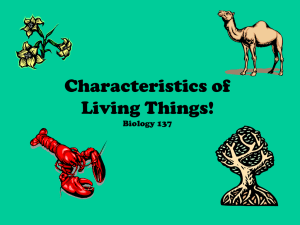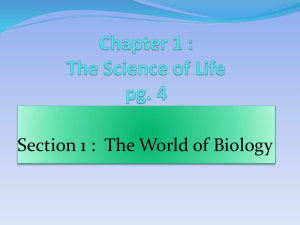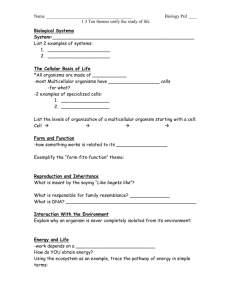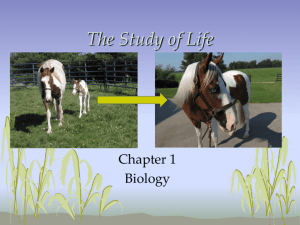the study of biology
advertisement
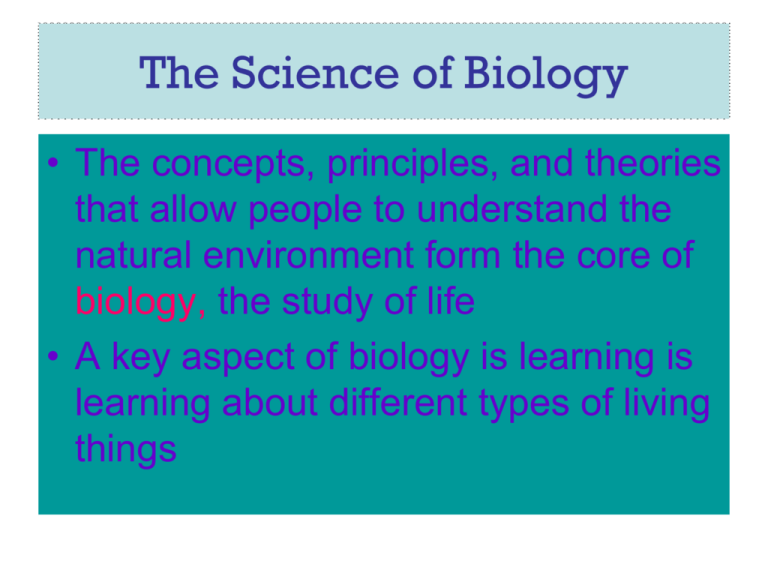
The Science of Biology • The concepts, principles, and theories that allow people to understand the natural environment form the core of biology, the study of life • A key aspect of biology is learning is learning about different types of living things The Study of Biology Biology" comes from two Greek words, "bios" meaning life, and "logos" meaning study. Biology is the study of life. Biologists study the interactions of life • One of the most general principles in biology is that living things do not exist in isolation; they are all functioning parts in the delicate balance of nature Biologists study the interactions of life • Living things interact with their environment and depend upon other living and nonliving things to aid their survival Biologists study the Diversity of Life • Through your study of biology, you will come to appreciate the great diversity of life on Earth and the way all living organisms fit into the dynamic pattern of life on our planet Biologists study the interactions of the environment • Because no living things, including humans, exist in isolation, the study of biology must include the investigation of living interactions. • The study of one living thing always involves the study of the others with which it interacts. Biologists study problems and propose solutions • The study of biology will teach you how humans function and how we fit in with the rest of the natural world. • It will also equip you with the knowledge you need to help sustain this planet’s web of life. Characteristics of Living Things • Biologists have formulated a list of characteristics by which we can recognize living things. • Only when something has all of them can it then be considered living. Characteristics of Living Things • Anything that possesses all of the characteristics of life is known as an organism 1. Living things are composed of cells • An animal cell 2. Living things are organized • When biologists search for signs of life, one of the first things they look for is structure. That’s because they know that all living things show an orderly structure, or organization. • Whether an organism is made up of one cell or billions of cells, all of its parts function together in an orderly, living system. Living creatures are ORGANIZED • All made of the same collection of chemicals, but we are organized as… – molecules • proteins, fats, carbohydrates, nucleic acids carbohydrates proteins DNA Living creatures are ORGANIZED • All made of the same collection of chemicals, but we are organized as… – organelles & cells • plant cells & animal cells plant cell animal cell Living creatures are ORGANIZED • All made of the same collection of chemicals, but we are organized as… – organs & organ systems • respiratory, circulatory, digestive, etc. 3. Living things use energy • Energy is the ability to cause change. • Living things reproduce themselves, grow and develop, respond to external stimuli, and maintain homeostasis by using energy. 4. Living things respond to their environment • Organisms live in a constant interface with their surroundings, or environment, which includes the air, water, weather, temperature, any other organisms in the area, and many other factors. • Regulation of an organism’s internal environment to maintain conditions suitable for its survival is called homeostasis. Anything in an organism’s external or internal environment that causes the organism to react is a stimulus A reaction to a stimulus is a response. Living creatures RESPOND • Respond to internal changes – Homeostasis • maintaining balanced conditions inside the body • Respond to external changes Homeostasis An example is the adjustment an organism makes in the amount of water in its cells; without the ability to make such adjustments, organisms die. 5. Living things grow • Growth results in an increase in the amount of living material and the formation of new structures.(cell division) • All organisms grow, with different parts of the organism growing at different rates. • All of the changes that take place during the life of an organism are known as its development 6. Living creatures REPRODUCE • Make the next generation Living things make more living things • Reproduction~ the production of offspring. • (necessary for species *to survive; not necessary for individual organism’s survival) • 2 types: – 1. asexual: 1 parent: offspring identical to parent – 2. sexual: 2 parents, offspring not identical to parents • * A species is a group of organisms that can interbreed and produce fertile offspring in nature 7.Living things adapt and evolve • Any structure, behavior, or internal process that enables an organism to respond to environmental factors and live to produce offspring is called an adaptation. • Adaptations are inherited from previous generations. • The gradual change in a species through adaptations over time is evolution.


